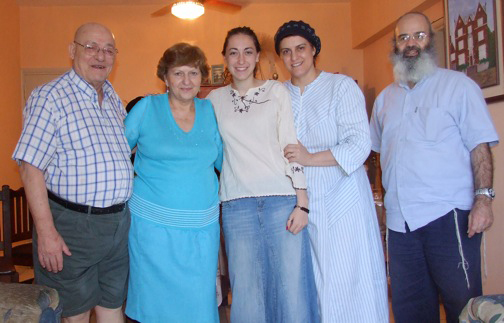
Wild turkeys visited our friends' backyard, leading to the question: Is turkey kosher?
This week, Rabbi Ben and I went to visit one of his friends in New Jersey. I was sitting in the living room, working on my laptop, when I heard his friend’s mom outside, talking to her grandson. “Look at the wild turkeys!” she was saying. Wild turkeys?
Yes, wild turkeys! I grabbed my camera and took a few photos. We weren’t sure what they were doing in the middle of a suburban development, but they sure were pretty. And we were all amazed at how tame they seemed to be. They weren’t afraid of us at all and let us get almost close enough to touch them! Of course, someone had to suggest that we catch them and eat them. Fortunately, nobody around was certified as a shochet (ritual kosher butcher), so the wild turkeys went free.
But wait – is turkey even kosher?
This week’s parsha includes a long list of birds we’re not allowed to eat. According to one translation, these include: the griffon vulture, the bearded vulture, the black vulture, the buzzard, the kite, all kinds of hawks, all kinds of ravens, the dark desert owl, the kestrel, the gull, all kinds of sparrow hawks, the little owl, the long eared owl, barn and screech owls, the nigh prowler, the gier eagle, the fish owl, the stork, all kinds of herons, the hoopoe, and the bat. We learn from the Torah and from the sages that we don’t eat birds that feed off carrion, nor do we eat carnivorous birds (including those that eat fish). We also learn that kosher birds must “have an extra toe or a crop or a gizzard that can be peeled by hand.”
The turkey certainly does seem to meet all the requirements set forth in the Torah for being a kosher bird. However, in Judaism, we also have a concept that if we don’t have a tradition of eating something, it’s not kosher for us. That’s why certain Jews living in Africa still have a tradition of eating locusts, but most of us couldn’t try them. (I’m so disappointed!) Up until the European discovery of the Americas, there were no Jews in North America and, therefore, no tradition of eating turkey. So what did they do when they got here and discovered turkey, a bird with all the signs but none of the tradition?

A wild turkey foraging for food. Turkeys have all the signs of being a kosher bird.
When the Jews first came to North America, they were divided into two camps vis-a-vis the turkey. Half the Jews took to their new home well and accepted the turkey as kosher as part of their adjustment. The other half insisted that because there was no tradition of eating turkey, it’s not kosher. So, where does that leave us today?
Today, turkey is considered to be a kosher bird. Jews in North America have been eating turkey now for over 250 years, which is more than enough time to establish a tradition of eating it. And although a few Eastern European Jews might still cling to their great-great-great grandfathers’ traditions of it not being kosher, turkey has become an incredibly popular Jewish food overall. In fact, Israelis eat more turkey per person each year than Americans do!
So go ahead and enjoy some turkey this Shabbos! SHABBAT SHALOM!
Read More












